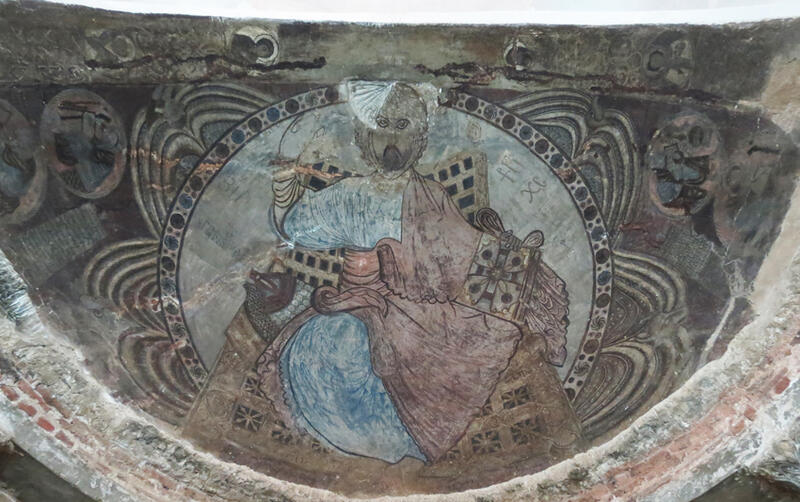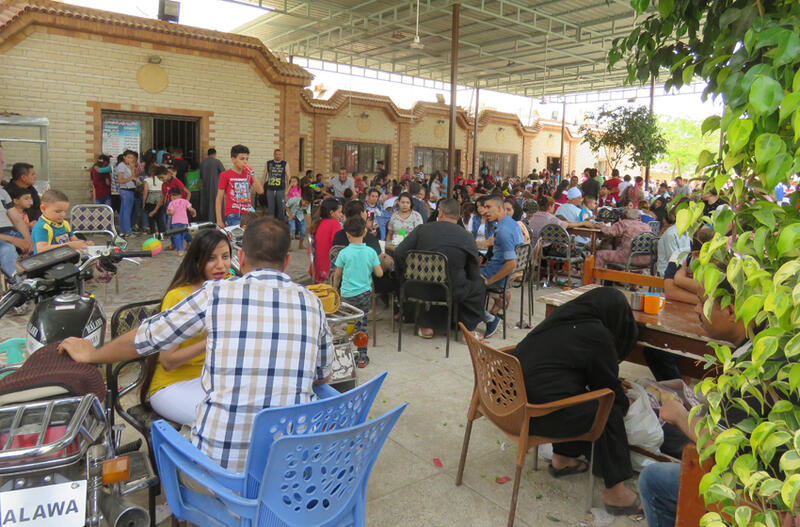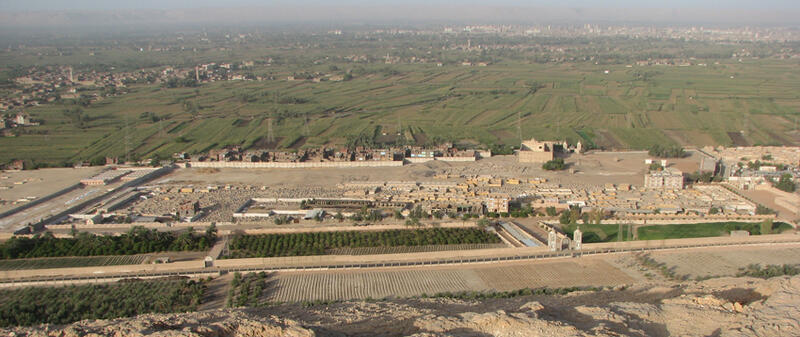The White Monastery
The White Monastery (Dayr al-Abyaḍ), or the Monastery of St. Shenoute (Dayr al-Anbā Shinūdah) is located at the edge of the desert 8 km to the west of the modern city of Sohag (fig. 1). The ancient monastery was the primary member of a federation that also included the Red Monastery (Dayr al-Ahmar) to the north and the women’s foundation to the south at Atripe.
Figure 1. The White Monastery as it appeared in 2008, looking from the desert cliffs to the west across the Nile valley to the east.
The heyday of the White Monastery began under the leadership of the charismatic Shenoute, who was head of the federation from the late fourth to the mid-fifth century, and under whose auspices the church was built.[1] Shenoute’s writings, which survive in two collections (the Canons and the Discourses), provide insights into many aspects of late ancient monastic life.[2] The monastery continued to flourish into the medieval period, when an Armenian artist called Theodore was commissioned to paint the eastern semi-dome composition of Christ in Majesty (fig. 2).[3] When the historian al-Maqrīzī visited in the early fifteenth century, he notes that the monastery was “destroyed,” with only the church standing.[4] The earliest depiction of the monastery, a seventeenth-century sketch by German theologian and linguist Johann Michael Wansleben, shows the church surrounded by mounds of ruins and suggests that the monastery had not been repopulated.[5]

Figure 2. Image of Christ in Majesty in the eastern semi-dome of the Church of St. Shenoute, as it appeared in 2015. Theodore’s text is in the grey rectangle on the left side of the photograph.
By the late nineteenth century, the standing Church of St. Shenoute had come to be identified as the monastery itself. It was inhabited by Christian villagers who had built their houses inside the now roofless nave of the church, as well as by the resident priests who continued to perform services within the sanctuary.[6] These houses were cleared during a major conservation project in the early twentieth century. New houses were later built but were finally removed in the mid-1980s by the Egyptian Antiquities Authority (EAO, later the Supreme Council for Antiquities) as a prelude to their excavations, which have continued episodically up to the present day.[7] In 2002, an international consortium of scholars began a project of survey, excavation, and conservation. In 2008, the commission was transferred to the Yale Monastic Archaeology Project (YMAP-South), which continues to sponsor archaeological work on site.
Since its resettlement by monks from the Monastery of St. Antony at the Red Sea in 1975, the monastery has flourished, becoming a hub for the local Christian community (fig. 3) and an active place of visitation for pilgrims, with thousands of visitors attending the festival (mūlid) of St. Shenoute, held in July every year.

Figure 3. Members of the local Coptic community enjoying the White Monastery cafeteria, Easter 2019.
YMAP-South Publications
In order to comprehensively document YMAP’s work at the White Monastery, a multi-volume series is planned for publication in the Yale Egyptological Publications (YEP) series. The first volume is already available:
Blanke, L. An Archaeology of Egyptian Monasticism: Settlement, Economy and Daily Life at the White Monastery Federation. Yale Egyptological Publications 2. New Haven: Yale Egyptology, 2019.
Other volumes planned or in preparation:
Architectural Survey of the Church of St. Shenoute (Layton and Burgoyne)
Funerary Chapel (Bolman, Davis, Pyke, Blanke, Dolling, Ownby, Stevens, and others)
Material Culture of the White Monastery (Pyke, Ownby, and others)
In addition to these volumes, a series of articles has been published or are forthcoming, documenting aspects of YMAP’s archaeological work at the White Monastery:
Blanke, L. “The Allure of the Saint: Late Antique Pilgrimage to the Monastery of St Shenoute.” In Excavating Pilgrimage. Archaeological Approaches to Sacred Travel and Movement in the Ancient World, ed. T. M. Kristensen and W. Friese, 203–223. Abingdon and New York: Routledge, 2017.
Blanke, L. “Life on the Desert’s Edge: The Water Supply of a Late Antique Monastery in Egypt,” In Water of Life, ed. J. Kuhlmann Madsen, N. Overgaard Andersen, and I. Thuesen, 130–143. Copenhagen: Orbis, 2016.
Bolman, E. S., S. J. Davis, and G. Pyke. “Shenoute and a Recently Discovered Tomb Chapel at the White Monastery,” Journal of Early Christian Studies 18.3 (2010), 453–462.
Davis, S. J., “Archaeology at the White Monastery,” Coptica 9 (2010), 25–58.
Davis, S. J., “Archaeology at the Shenoutean Monastic Federation, 2010–2019: A Report on the Last Decade of YMAP’s Work,” Coptica 19 (2020), forthcoming.
Davis, S. J., with contributions by E. Bolman, D. L. Brooks Hedstrom, and G. Pyke, “Life and Death in Lower and Upper Egypt: A Brief Survey of Recent Monastic Archaeology at Yale,” Journal of the Canadian Society for Coptic Studies 3 (2012), 9–26.
Davis, S. J., P. Gasparri, G. Pyke, and N. Warner, “Digital Preservation at the White Monastery in Sohag: A Three-Dimensional Survey,” Scribe 7 (2021), forthcoming.
Davis, S. J., G. Pyke, E. Davidson, M. Farag, and D. Schriever, “Left Behind: A Recent Discovery of Manuscripts Fragments in the White Monastery Church,” Journal of Coptic Studies 16 (2014), 69–87.
Davis, S. J., G. Pyke, and N. Warner, “Architectural Conservation at the White Monastery Church (Dayr Anba Shinuda), Sohag,” Bulletin of the American Research Center in Egypt 208 (2016), 34–41.
Further Reading
Bénazeth, D., and A. Boud’hors. “Les clés de Sohag: Somptueux emblems d’une austere reclusion.” In Études coptes VIII, Actes de la 10e journée d’éudes coptes (Lille, 14-16 juin 2001), ed. C. Cannuyer. Cahiers de la Bibliothèque Copte 13, 19–36. Lille: Association francophone de coptologie, 2003.
Bock, W. de. Matériaux pour servir à l’archéologie de l’Égypte chrétienne. St Petersburg: Eugène Thiele, 1901.
Bolman, E. S. “A Medieval Flourishing at the White Monastery Federation. Material Culture.” In The Red Monastery Church, ed. E. S. Bolman, 203–215.
Bolman, E. S. The Red Monastery Church: Beauty and Asceticism in Upper Egypt, ed. E. S. Bolman. New Haven and London: Yale University Press American University in Cairo Press, 2016.
Bolman, E. S. “The White Monastery Federation and the Angelic Life.” In Byzantium and Islam: Age of Transition, 7th–9th Century, ed. Helen C. Evans and Brandie Ratliff, 75–77. New Haven & London: Yale University Press/ American University in Cairo Press, 2012.
Bolman, E. S., L. Blanke, D. Brooks Hedstrom, M. Khalifa, C. Meurice, S. Mohammed, G. Pyke, and P. Sheehan. “Late Antique and Medieval Painted Decoration at the White Monastery (Dayr al-Abiad), Sohag,” Bulletin of the American Research Center in Cairo 192 (2007), 5–11.
Bolman, E. S., L. de Cesaris, A. Sucato, E. Ricchi, M. Kacicnik, S. M. M. Osman, A. Z. Aly, S. J. Davis, Fr. M. al-Anthony, G. Pyke and A. Szymanska. “The Tomb of St. Shenoute at the White Monastery: Final Conservation and Documentation,” Bulletin of the American Research Center in Egypt 204 (2014), 21–24.
Bolman, E. S., L. de Cesaris, G. Pyke, E. Ricchi and A. Sucato. “A Late Antique Funerary Chapel at the White Monastery (Dayr Anba Shenouda), Sohag,” Bulletin of the American Research Center in Egypt 195 (2009), 12–18.
Bolman, E. S., S. J. Davis, L. de Cesaris, Fr. M. el-Anthony, G. Pyke, E. Ricchi, A. Sucato and N. Warner, “The Tomb of St. Shenoute? More Results from the White Monastery (Dayr Anba Shenouda), Sohag,” Bulletin of the American Research Center in Egypt 198 (2011), 31–38.
Boud’hors, A. Le Canon 8 de Chenoute: d’apres le Manuscrit IFAO Copte 2 et les Fragments Complementaires. Cairo: Institut français d’archéologie orientale, 2013.
Brooks Hedstrom, D. L. “An Archaeological Mission for the White Monastery,” Coptica 4 (2005): 1–26.
Brooks Hedstrom, D. L., and E. S. Bolman. “The White Monastery Federation Project: Survey and Mapping at the Monastery of Apa Shenoute (Dayr al-Anba Shinūda), Sohag, 2005–2007,” Dumbarton Oaks Papers 65–66 (2012), 1–32.
Crum, W. E. “Inscriptions from Shenoute’s Monastery,” Journal of Theological Studies 5 (1904): 552–569.
Grossmann, P. “New Observations in the Church and Sanctuary of Dayr Anbā Šinūda—the So-called White Monastery—at Sūhāg: Results of Two Surveys in October, 1981 and January, 1882,” Annales du Service des antiquités de l’Égypte 70 (1984/1985), 69–73, and pl. 1.
Grossmann, P., D. L. Brooks Hedstrom, M. Abdal-Rassul, and E. S. Bolman. “The Excavation in the Monastery of Apa Shenute (Dayr Anba Shinuda) at Suhag,” Dumbarton Oaks Papers 58 (2004), 371–382.
Grossmann, P., D. L. Brooks Hedstrom, S. M. M. Osman, H-C. Noeske, M. A. Abd al-Rahim, T. S. Abd al-Fatah, and M. Abd al-Mugdi. “Second Report on the Excavation in the Monastery of Apa Shenute (Dayr Anba Shinuda) at Sohag,” Dumbarton Oaks Papers 63 (2009), 167219.
Layton, B. The Canons of Our Fathers: Monastic Rules of Shenoute. Oxford: Oxford University Press, 2014.
Layton, B. “Rules, Patterns, and the Exercise of Power in Shenoute’s Monastery: The Problem of World Replacement and Identity Maintenance,” Journal of Early Christian Studies 15 (2007), 45–73.
Layton, B. “Social Structure and Food Consumption in an Early Christian Monastery: The Evidence of Shenoute’s Canons and the White Monastery Federation A.D. 385–465,” Le Muséon 115 (2002), 25–55.
Meurice, C. “L’intervention du Comité de conservation des monuments de l’art arabe au couvent Blanc de Sohag.” In Études coptes XI, Treizième journée d’études (Marseilles, 7–9 juin 2007), ed. A. Boud’hors and C. Louis. Cahiers de la bibliothèque copte 17, 277–288. Paris: De Boccard, 2010.
Mohamed, M. A., and P. Grossmann. “On the Recently Excavated Monastic Buildings in Dayr Anba Shinuda: Archaeological Report,” Bulletin de la societé d’archéologie copte 30 (1991), 53–63.
Monneret de Villard, U. Les couvents près de Sohâg (Deyr el-Abiaḍ et Deyr el-Aḥmar). 2 volumes. Milan: Tipografia Pontificia e Arcivescovile S. Giuseppe, 1925–1926.
Peers, C. R. “The White Monastery Near Sohag, Upper Egypt,” Archaeological Journal 61 (1904), 131–153.
Petrie, W. M. F. Athribis. British School of Archaeology in Egypt and Egyptian Research Account 14. London: School of Archaeology in Egypt/Bernard Quaritch, 1908.
Sellew, P., ed. Living for Eternity: The White Monastery and its Neighbourhood: Proceedings of a Symposium at the University of Minnesota, Minneapolis, March 6–9, 2003. Published online: http://egypt.umn.edu/Egypt/1-pb%20pdfs/Bren.pdf.
Somers Clarke, G. Christian Antiquities in the Nile Valley: A Contribution Towards the Study of the Ancient Churches. Oxford: Clarendon, 1912.
Swanson, M. N. “An Eclipsed History: Towards a Framework for the Medieval History of the Red Monastery,” inThe Red Monastery Church: Beauty and Asceticism in Upper Egypt, ed. E. S. Bolman, 193–201. New Haven and London: Yale University Press and the American University in Cairo Press, 2016.
Warner, N. “The Errant Eye: Johann Michael Wansleben and the Monasteries of Suhāg.” In Scholarship Between Europe and the Levant, ed. J. Loop and J. Kraye. The History of Oriental Studies 8, 149–172. Leiden: Brill, 2020.
Warner, N., and C. Meurice. “‘A Strange Jumble of Roman Detail’: Western Explorers and Antiquarians at the Red Monastery, 1673–1926.” In The Red Monastery Church, ed. E. S. Bolman, 231–242.
[1] Pseudo-Besa, The Life of Shenoute, trans. D. N. Bell (Kalamazoo: Cistercian Publications, 1983), 51–52.
[2] An international project to produce a critical edition of Shenoute’s writings is currently underway, led by Stephen Emmel; see also A. Boud’hors, Le Canon 8 de Chenoute: d’apres le Manuscrit IFAO Copte 2 et les Fragments complementaires (Cairo: Institut français d’archéologie orientale, 2013). On the monastic rules of Shenoute’s federation, edited from citations in his Canons, see Layton, The Canons of Our Fathers: Monastic Rules of Shenoute (Oxford: Oxford University Press, 2014). For thematic studies based on this corpus, see, for example, B. Layton, “Social Structure and Food Consumption in an Early Christian Monastery: The Evidence of Shenoute’s Canons and the White Monastery Federation A.D. 385–465,” Le Muséon 115 (2002), 25–55; B. Layton, “Rules, Patterns, and the Exercise of Power in Shenoute’s Monastery: The Problem of World Replacement and Identity Maintenance,” Journal of Early Christian Studies 15 (2007), 45–73.
[3] For Theodore’s painting, see: M. N. Swanson, “An Eclipsed History: Towards a Framework for the Medieval History of the Red Monastery,” in The Red Monastery Church: Beauty and Asceticism in Upper Egypt, ed. E. S. Bolman (New Haven and London: Yale University Press and the American University in Cairo Press, 2016), 193–201, at 198, fig. 15.2. Swanson’s article provides a detailed overview of both the Red and White Monasteries in the medieval period.
[4] al-Maqrīzī, “Account of the Monasteries and Churches of the Christians of Egypt; Forming the Concluding Sections of the Khiṭaṭ of al-Makrīzī,” in The Churches and Monasteries of Egypt and Some Neighbouring Countries, Attributed to Abu Salih, the Armenian, ed. B. T. A. Evetts (Oxford: Clarendon, 1895), 317; Swanson, “Eclipsed History,” 199.
[5] N. Warner, “The Errant Eye: Johann Michael Wansleben and the Monasteries of Suhāg,” in Scholarship Between Europe and the Levant, ed. J. Loop and J. Kraye (The History of Oriental Studies 8; Leiden: Brill, 2020), 149–172; N. Warner and C. Meurice, “‘A Strange Jumble of Roman Detail’: Western Explorers and Antiquarians at the Red Monastery, 1673–1926,” in The Red Monastery Church, ed. E. S. Bolman, 231–242, 232–233, fig. 18.2.
[6] W. de Bock, Matériaux pour servir à l’archéologie de l’Égypte chrétienne (St. Petersburg: Eugène Thiele, 1901), 49, pls. XIX–XX; C. R. Peers, “The White Monastery Near Sohag, Upper Egypt,” Archaeological Journal 61 (1904), 134; G. Somers Clarke, Christian Antiquities in the Nile Valley: A Contribution Towards the Study of the Ancient Churches (Oxford: Clarendon, 1912), 158–159.
[7] L. Blanke, An Archaeology of Egyptian Monasticism: Settlement, Economy and Daily Life at the White Monastery Federation (Yale Egyptological Publications 2; New Haven: Yale Egyptology, 2018), 54–57. Excavation has continued since Blanke’s work was published.

